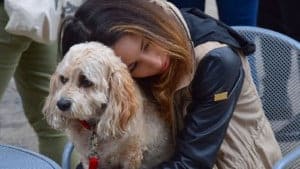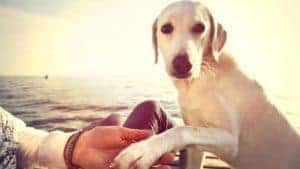Have you heard of the tale of Balto, the Siberian husky? Even today, the people of Nome share the store of this sled dog, as he and a brave musher saved of Nome in 1925! Just 2 degrees south of the freezing Arctic Circle, Nome, Alaska, only had one route to the rest of the world in winter: the Iditarod Trail.
When a severe disease epidemic left the people of Nome struggling to survive, they were in dire need of medicine from far away. But how could that medicine get to them, especially when it was, realistically, much too dangerous to travel now? Well, that’s where Balto, the sled dog, comes in.
This Scrub Dog Saved An Alaskan Town From Certain Death
1. The Plight of Nome
The tale of Balto begins in Nome, Alaska, all the way back in 1925. It was January when Diptheria, a nose and throat disease, began infecting the little town, with small symptoms appearing in residents.
At the time, diphtheria spread rapidly throughout America, infecting more than 15,000 people by 1921. While in 2015, only 2,100 deaths were recorded from diphtheria – a positive step forward from 8,000 in 1980 – back then, a lack of knowledge of the disease and treatment options meant countless lives were lost.
As such, it was no surprise that the town was terrified as the disease spread further and further, as it was especially dangerous for small, rural areas. These isolated places often don’t have access to treatment options, as urban centers held most of the resources for treatment.
And that was where the antitoxin was – in Anchorage, more than 500 miles away. It was the only cure for the disease at the time, Worse yet, travel was virtually impossible thanks to the harshness of the winter of Alaska.
 2. The Potential Solution
2. The Potential Solution
To same Nome’s residents, dogsled drivers gathered together in a team, pooling their resources together with the aim of making the difficult and very dangerous journey to Nome. This transportation relay process would run through 650 miles in what would later be known as the Great Race Of Mercy.
There was only one path leading to Nome, and it spanned 650 miles. Ordinarily, a single person or team would need more than a month to get to Nome, which would have been much too late. So the people broke the path up into journeys of stretches that they would complete by relay. This option would break the time down significantly for more positive results.
The journey began in Nenana, which is a town that Anchorage sent the serum to. Balto was responsible for finishing the last of the rush. The routes used over 674 miles from Nenana to Nome were as follows:
- Nenana to Tanana: 137 miles over Alaska Interior and Tanana River
- Tanana to Kaltag: 230 miles along Yukon river
- Kaltag to Unalakleet: 90 miles west over Kaltag Portage
- Unalakleet to Nome: 208 miles around Seward Peninsula south shore, including 42 miles across the Bering Sea across shifting ice
3. Balto’s Role
Balto, a black-and-white Siberian husky known for being a lazy sled dog and a slow worker, would normally not have been considered for such a difficult journey. But Gunnar Kaasen had positive thinking and chose to use Balto as his frontrunner and the leader of his pack. When it was their turn to go, there was a terrible storm. But after 3 hours, the storm hadn’t let up, and Kaasen knew they had to go anyway.
They began their journey at 10 pm and traveled through the night in these conditions:
- Drifts
- River overflow
- 600-foot climb over the Topkok Mountain
- Very low visibility; Kaasen could not even see the dogs closest to him sometimes
Despite these conditions, Balto pressed on, guiding the sled faithfully. Unfortunately, they passed the next relay point at Solomon by 2 miles before Kaasen realized they’d gone too far. So what did he do? Well, they kept on going!
But once they passed Solomon, the winds grew more severe, and their sled flipped over, Kaasen was horrified when the serum fell off in the commotion, and he had to use his bare hands to feel around for the delicate cargo, which left him with frostbite.
Finally, at 3 in the morning on the 2nd of February and far ahead of schedule, Kaasen arrived at the next relay point known as Point Safety. But the sled-driver here, Ed Rohn, thought that the relay had stopped at Solomon, and Kaasen had arrived much earlier than planned as no messages had been received, so he was asleep.
Once again, Kaasen was in an unusual position. But he saw that the dogs were moving incredibly, so he decided to keep going over the final 25-mile stretch to Nome. He reached Front Street, Nome, at half-past five in the morning, only six days after the rush to Nome began. Within a few hours, all the antitoxin serum, safe and sound, was thawed. The people of Nome were saved.
4. Balto’s Legacy
Though Balto traveled for just the last 55 miles, there’s no way to deny that the celebration thrown in his honor was well worth it. Balto never steered away from the road, he never faltered, and he kept going through impossible circumstances.
Even in New York, Balto was honored with a statue, which you can still see today in Central Park in Manhattan. A film was even made of Balto’s journey by Universal Pictures in 1995 – an animated movie for kids, telling the tale of Balto’s legacy.
At the age of 14, in 1933, Balto passed away. His body was saved and preserved and now is on display in Cleveland, Ohio, in the Cleveland Museum of Natural History.
5. The Other Mushers and Sled Dogs On The Run To Nome
Twenty different mushers and approximately 150 dogs all made the collective 674-mile trip to Nome with the 20-pound package of serum. It wasn’t only Balto who did an amazing job! Here are the rest of them:
· “Wild Bill” Shannon
Shannon was the first musher to embark on the journey, leaving at 9 pm on the 27th of January. He braved the way with 11 inexperienced dogs with one named Blackie in the lead. When they found their trail destroyed by horses, they had no choice but to cross a frozen river.
Eventually, Shannon made it to Minto with facial features blackened due to frostbite and hypothermia. It was -62 degrees. Shannon was forced to leave behind three exhausted dogs and go onto Tolovana with just eight after a four-hour rest. He arrived at 11 am. Though he returned for the three dogs, they passed away shortly after.
· Edgar Kalland
Kalland, a Half-Athabaskan, first came to Minto but had to return to Tolovana to meet Shannon. He traveled 70 miles before even receiving his relay. Once he got the serum, he went through the forest in -56-degree temperatures. When he got to Manley at 4 pm, water had to be poured over his hands, which had frozen to the handlebar of the sled.
· Anonymous Athabascans
To speed up the process, multiple Athabascans wound up helping to transport the serum between them.
· George Nollner
History did not record much of Nollner’s journey, but he arrived at the Bishop Mountain relay point at 3 in the morning on the 30th of January.
· Charlie Evans
Evans left through the Koyukuk river, but his short-haired mixed breed dogs were no match for the brutal weather. Sadly, two of them collapsed due to frostbite. Evans had to help pull the sled along the way. He got to his point at 10 in the morning, but both dogs had passed away by then.
· Tommy Patsy
Patsy left almost immediately. Historians did not record his journey.
· Jack “Jackscrew” Nicolai
Nicolai crossed over the Kaltag Portage. Local history books don’t share much about his journey.
· Victor Anagick
Anagick, an Alaska native, traveled to the Sound in Unalakleet and arrived at 5 in the morning on the 31st of January.
· Myles Gonangnan
Also, an Alaska native, Gonangman noticed a storm on the horizon and decided not to take the easy but dangerous shortcut across Sound’s ice. He left at 5:30 in the morning and crossed hills quickly. Whiteout conditions finally cleared up as he got to the shore, with temperatures at -70 degrees. He arrived at Shaktoolik at 3 in the afternoon.
· Henry Ivanoff
Originally, Gonangman intended to pass the serums to Leonhard Seppala, a Nome native. However, because Seppala was not there yet, Ivanoff stood by to make the next leg of the journey. His sled dog team accidentally crashed into a reindeer and became tangled up, and he didn’t actually get to the next point.
· Leonhard Seppala
An experienced musher, Seppala made the trip from Nome towards Shaktoolik on the 27th of January and got close on the 31st, thanks to the Norton Sound shortcut. The wind chill of -85 degrees was biting as he rushed on. His lead dog, Togo, ran 350 miles. Seppala thought he had over 100 miles left to go, but then he heard Ivanoff’s voice calling for him and saying he had the serum!
Seppala chose to brave the storm as word reached him that the epidemic worsened. He reached Ungalik after dark but carried on, eventually getting to Isaac’s Point at 8 o’clock that night. After a rest, they left at 2 in the morning, into the storm with the wind at 65 mph. They climbed 5,000 feet over Little McKinley Mountain before getting to Golovin at 3 in the afternoon on the 1st of February. This was the most brutal leg of the relay.
· Charlie Olsen
The storm was very bad, and wind chills were at -70 degrees when Olsen took off. He somehow got away from the trail. Instead of looking after himself, he used using his blankets for his sled dogs, which caused his hands to develop severe frostbite. He got to Bluff at 7 in the evening on the 1st of February, where he passed the serum to the last musher: Gunnar Kaasen. Thankfully, frostbite is treatable, and injury-relief medications had positive results on it, in Charlie’s case.
 Final Thoughts On How A Sled Dog Saved A Town From Certain Death
Final Thoughts On How A Sled Dog Saved A Town From Certain Death
Balto and his team – as well as all the other dogsledders on the 1925 serum run – did something truly amazing for Nome. With bravery, positive thinking, and strength, they fought against all the odds to save a rural community. These people and sled dogs are heroes, and their legacy should live on forever!





















